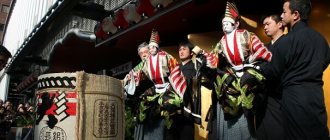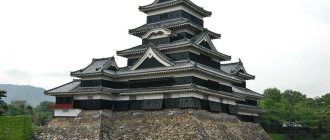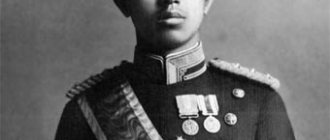Naginata is a melee weapon originally from the Land of the Rising Sun. Its distinctive feature is the solid length of the shaft and blade. Some of the weapons that have survived to this day had a one and a half meter shaft and a blade about 60 centimeters long. Essentially, we are talking about the symbiosis of a spear and a sword.
Like many other things that appeared in Japan, for a long time the naginata was not known outside the islands. However, it had an analogue in Europe - the glaive. This once again proves that Eastern and Western civilizations developed in parallel.
Use in combat
The main factor in combat flails is the speed with which the blow is struck, therefore the striking technique used in battles implied a wrist blow with a short swing or without one at all.
The blow itself had to hit the enemy's head or body; it was even possible to hit his unprotected back (due to the presence of a rather long chain). This was due to the fact that the flail is a weapon of the first strike, and it was almost impossible to defend with it.
Even with a metal flail handle, it was almost impossible to repel a blow (no matter what weapon) due to the unpredictable behavior of this handle and the load. It’s beautifully shown in films that with a flail or just a chain you can take away a sword or pike from an enemy
In practice, everything is not so clear. You can get injured from your own flail
The films beautifully show that with a flail or just a chain you can take away a sword or pike from an enemy. In practice, everything is not so clear. You can get wounded by your own flail.
Light cavalrymen successfully used the flail as an additional weapon in the lands of Ancient Rus'. This is due to the difference in the history of Europe and the eastern part of Ancient Rus', to which the era of chivalry did not reach.
In Europe, in the Middle Ages, heavily armed knights on the battlefield, who relied on the force of the blow, and not on its speed, used the flail extremely rarely. Heavy ammunition did not allow for a quick wrist strike, and the weapon itself was considered a weapon of commoners.
The use of this weapon by knights was recorded only in cases when in battle he was deprived of his more familiar weapons - a sword, spear, battle axe, and this applies to the morning star, and not to the flail.
On the other hand, having a saber and a flail technique proven in battle, a lightly armed warrior penetrated the defense of a heavily armed shield-bearer. The low cost of production made it possible to easily and in a short time arm an army of rebel peasants or conscripted militias, since their weapons were non-combatant.
It should be remembered what the Hussite camp was like - these were war carts placed in a circle, behind which the army was hiding.
When the enemy tried to break into the camp, each of the defenders had time for one blow. The Czech peasants with these weapons (which by that time had become similar to a morning star) were able to successfully go on the attack, literally mowing down a number of enemy soldiers at the first blow.
With the development of technology, edged weapons were increasingly replaced by firearms. This trend did not bypass flails, although their last use in battle was recorded during the First World War. But this was the improvisation of individual soldiers, and not generally accepted army practice.
Naginatajutsu
Nowadays, the naginata is part of the sport style of naginatajutsu. This is a martial art that is somewhat similar to kendo (a katana technique). Training naginatas range between 210 and 225 centimeters. The protective equipment is almost identical to that used for kendo, with minor differences - gloves have an index finger, which distinguishes them from mittens for kendo, and in naginatajutsu they use protection for the legs, since some of the techniques are aimed specifically at hitting the lower part of the body, in contrast from kendo, which focuses on striking the opponent's head and torso. Naginatajutsu is a rather unpopular form of martial arts, so it is rare to find entire federations or large associations of practicing trainers outside of Japan. Often, those who want to comprehend this Japanese art have to look for information themselves and practice together with kendoists. In Japan, sparring sessions between athletes involved in kendo and naginatojutsu often take place.
Naginata today
Now the naginata is one of the symbols of Japan. Yes, it is not as famous as the katana, but it also regularly appears in modern culture (cinema, anime, etc.). Similar weapons are very easy to find in museums, and some of the exhibits can boast of a glorious history stretching back centuries.
In the homeland of weapons, you can still learn how to use them. In addition to specialized schools, there are also thematic courses in some general education institutions. Not only boys, but also girls master the art of naginata.
There is also an International Naginata Federation with branches in Russia, the USA and a number of other countries. Now this is another martial art with two varieties: a duel and a demonstration of weapons technique. If you ever have the opportunity to attend a competition like this, be sure to do so.
Art of War - exhibition of Japanese armor and weapons
Art of War. Exhibition of samurai armor and weapons.
Takes place at the Museum of the East. It runs from October 21 all the way to January 13, but there are still no fewer people wanting to watch it. So be prepared to stand in line for half an hour. A ticket costs 200 rubles and allows you to go to the main exhibition of the museum, which is very interesting. A photo costs one hundred rubles, and permission will be checked meticulously and meticulously in every room. What if you didn’t pay?!
And further. I almost got there myself, and while I was standing in the hall, several other people were trying to make a mistake with their tickets. That’s why I’m telling you about the ticket quest. It goes like this. On the ground floor, you buy tickets from the fierce aunt for the right to take photographs (only for him!). Other questions are prohibited - you will receive an unkind answer. Because downstairs they only sell tickets for the main exhibition. Then you go up to the second floor, and there you buy tickets to the exhibition. You will then present the same tickets below if you want to visit the main exhibition, which I recommend. Discounts are not given to journalists, but are given to members of artistic associations.
samurai without a sword
like a samurai with a sword -
just without the sword
The Japanese sword is a unique phenomenon. Of course, there have been many great master blacksmiths in all corners of the globe at all times. And they created weapons that surpassed all imaginable and inconceivable limits. But these were always isolated cases, exceptional and rare. Only in Japan were they able to make the production of exceptionally high-quality swords a sustainable and widespread tradition with their own schools and skills passed down through generations. The Japanese sword is an alloy of three metallurgical cultures: Chinese, Korean and barbarian, “northern”. In fact, if back in the 3rd-5th centuries Chinese and Korean blades were massively imported to Japan, then already in the 8th century individual wonderful Japanese swords were exported to the continent.
Contrary to popular stereotypes, the main weapon of a warrior in ancient Japan was not a sword at all, but a spear and a bow. But from the 14th century infantry gradually began to replace the cavalry, and along with it the sword gradually became popular. And only in the 17th century, during the reign of the Tokugawa clan, the sword took a leading position.
Technically, in Japan, the term “nihon-to” (“Japanese sword”) includes all types of weapons that have a steel blade - swords, all kinds of knives, spears, spears, naginatas (not to be confused with halberds!). However, “to” does not mean any sword, but a curved one, with one-sided sharpening, made using specific Japanese technology. The straight blade is called “ken”. However, when the Japanese say sword, they mostly mean just that, a sword. For other types of weapons, they use their own names: so, yari, naginata, tanto, etc.
Simultaneously with the development of swords, masters competed with each other to create durable and protected armor. Multi-layered steel, plates fastened in such a way as to simultaneously protect and not hinder movement, completeness and beauty - all this is samurai armor.
However, the art of fencing truly developed in Japan when armor had no place. In fact, in the modern sense, kenjutsu was formed during the Edo period (1603-1867). Of course, before this there were also subtleties and styles, but first of all, the strength of the blow and the ability to take a blow were valued. Errors in defense were to some extent compensated for by heavy armor. But during the Edo period there were few wars. And there are many samurai. They wandered around cities and villages in civilian clothes, without armor, and were looking for a use for their skills. And they basically knew only one thing - to kill. Duels and skirmishes were commonplace at that time. But without armor, even a small glancing blow to the wrist could easily disable the hand. Therefore, it was necessary to develop new fighting techniques that did not allow the enemy to even touch the body with a blade, and at the same time, trying to hit the numerous vulnerabilities of an unprotected enemy. During this same period, Bushido's "samurai code of honor" was formalized. In fact, one of Bushido’s tasks was to contain the dueling bacchanalia. Many provisions of Bushido, calling for humility and politeness, are aimed at this.
The history of Japan is in many ways the history of its samurai class. And the soul of a samurai is a sword. Therefore, it is impossible to understand Japan without understanding the essence of its blades.
Flail
The contact-crushing device was widely valued in horse battles, when the enemy forces were dominant. Flail - a club on which there is a chain with a ball. The force of the blow was so great that the strongest armor was crushed and the enemy flew out of the saddle. The weapon was intended not only to kill, but also to disorient the enemy.
Origin story
The first maces appeared during the times of Rus'. The weapon had high striking power, but the lack of mobility and agility reduced its overall effectiveness. This shortcoming was noticed by European gunsmiths and at the end of the 10th century the first flail was born.
Weapons quickly gained relevance. The foot soldiers knocked out the horsemen, while being out of range of the swords. Weights on a chain began to be used by English knights, German and Italian horsemen. Heavily armed mounted infantry were placed in the front ranks to introduce discord and disorder into the enemy ranks.
The final modernization took place only in the 14th century. Long spikes appeared on the weight, the chain and club became longer. But there are fewer soldiers who can handle weapons due to their increased weight. Training began for warriors who knew exclusively the chain weight and techniques that allowed it to be used as efficiently as possible.
Description
The design of the flail implies mobility, agility and high striking power. The initial type of weapon was a club with a comfortable handle (50 centimeters) called a flail. At the other end there is a ball (weight) of different sizes and shapes. The fastening element is a strong iron chain, half a meter long.
During active hostilities, the flail was significantly modified. The fist was lengthened to 70 centimeters, the ball became larger and equipped with spikes. The iron chain was thickened, but its length remained the same.
Lengthening the mounting structure reduced mobility, since the warrior needed more effort to throw the flail at the enemy.
Varieties
In a combat situation, the only correct decision is adaptation to current events. An incorrectly selected weapon cost a warrior his life. The flail was effective only in close combat; it was useless against a spear or two-handed sword. To compensate for the shortcomings of weapons, several types were invented, intended for combat against infantry or cavalry:
- Standard type. Has its original appearance. Effective against mounted infantry and close combat. There were no spikes on the ball; the total diameter of the weight was 15-20 centimeters. It was impossible to inflict mortal damage on the enemy;
- The next type is contact-crushing weapons. It did not differ from the standard flail in design, but the weight was significantly modified. Spikes appeared, and the impact structure began to be made in a rhombic or square shape. Easily pierced weak armor;
- Morgenstern is the finished form of this weapon. Handle length – 60 centimeters. The Morgenstern was equipped with a special strap for convenient placement on the hand. Long spikes or small protrusions appeared on the weight. There is an opportunity to inflict a mortal wound on the enemy.
The flail is effective against infantry or horsemen wearing light armor. Even the morning star could not penetrate the strong armor. Modern interpretations of this weapon are intended only to stun and disorient the enemy.
History of weapons
As mentioned above, the first mention of naginata dates back to the beginning of the 8th century, it can be found in the famous Kojiki chronicle - a monumental monument of ancient Japanese literature. It mentioned sohei - legendary warrior priests - who used naginatas. It is likely that this weapon came to Japan from China (there is a very similar analogue called dadao), and then was significantly modified in accordance with Japanese military, craft and cultural traditions.
The naginata can be seen in historical drawings depicting battles of the Tenge period (10th century). The Chronicle of Three Years in Oshu (11th century) gives a detailed description of the use of this weapon in battle. From the narrative it becomes clear how highly the warriors of that period valued the fighting qualities of the naginata. In the 12th century, during the so-called Gempei War, the naginata became widespread as an effective weapon against enemy cavalry. The active use of this weapon even led to changes in traditional Japanese armor: in order to protect the legs of warriors from naginata blows, special shin protection was introduced.
Judging by ancient literary sources, the real virtuosos of using the naginata were the Sohei monks. We have reached colorful descriptions of fights using naginatas during fierce wars between the Minamoto and Taira samurai clans.
In the XIV-XV centuries. The naginata became somewhat shorter and received the shape that we know today. At the same time, the tactics of combat operations changed radically; on the battlefield, scattered groups of warriors were replaced by a closed formation of spearmen. The naginata was ineffective against long spears. In the 17th century, with the advent of firearms, the military significance of the naginata became even less.
However, the less useful the naginata became for men, the more attention Japanese women paid to this weapon. When exactly the samurai ladies “set their eyes on her” is difficult to say. In medieval Japan, female warriors were not such an exceptional phenomenon; the chronicles are full of descriptions of their exploits. However, in the early periods they more often used a bow or short sword for their military achievements. There was an opinion that the naginata is perfect for representatives of the fair half of humanity, since its length makes it possible to keep the enemy at a considerable distance and thus neutralizes the advantages of a man in height, strength and weight. Naturally, not all medieval Japanese women could afford to practice naginatajutsu; this was usually the privilege of aristocrats.
The noble women who lived in the dangerous border regions during those turbulent times were not effeminate or weak. If necessary, they fought alongside their husbands or brothers. At that time, their position in society was very high; they often became managers of their estates, which forced girls to train at least a minimum of military skills. It is likely that some Japanese ladies did not limit themselves to this very minimum.
The naginata very quickly became a status symbol for women of the samurai class, often being part of the dowry of girls from noble families. It was believed that with the help of this weapon, onna-bugaisha (“woman samurai”) was quite capable of protecting her home in the absence of her husband. A woman skilled in naginatajutsu could single-handedly defeat a gang of thugs who had entered her home.
“The Tale of Military Troubles in the Biti Region” describes how the wife of the samurai Mimura Kotoku, taking her favorite weapon and arming 83 other women, went into battle, “spinning her naginata like a mill wheel.” Then she challenged the leader of the attackers to a duel. The man refused to fight her, saying that she was a demon. The chronicle goes on to say that the women returned to the castle, making their way through the line of enemy warriors.
Already in the middle of the 15th century, many traditional schools of Japanese martial arts introduced naginatajutsu into the compulsory training program. It must be said that during the training the girls were not given any concessions; the requirements for them were as severe and stringent as for the boys when teaching them kendo.
One of the ancient Japanese treatises says that “learning naginata, home economics and sewing will make a woman ideal.” This is Kinder, Küche, Kirche (“kitchen, children, church”) in Japanese. It was believed that training with naginata instilled a strong will in women and allowed them to better understand samurai traditions in order to become an ideal warrior's wife.
TRIDENT
Trident
It is considered the most mythical weapon. It was customary to represent the two most important Roman gods with him: Jupiter and Poseidon. It was also considered a weapon for gladiator combat. It was used in fights reaching the highest cruelty.
At one time among such peoples as the Persians, and at another among the Turks and Huns, Slavs, Indians, and Germans, it was a weapon that seemed to them to give powerful advantages. In Ukraine and Mongolia, to this day it is possible to notice illustrations of the trident in various state paraphernalia.
The trident is a more developed type of spear connected to a hook. Initially it was a fishing tackle, with a blade. They slaughtered fish or various sea creatures with it.
The trident is a type of weapon used in Chinese martial arts.
Ji (analogous to a trident) dates back to the eleventh century. Allows you to perform many different techniques. The assembly mechanism allows the blade to inflict lacerations, significantly weakening the enemy. Also, with the correct use of a trident, it is possible to disarm an enemy by delivering blows that damage his hand. It also found echoes in the Hinduism and Buddhism religions. Used by their gods for protective and destructive properties.
It is also noted as the weapon of the devil among Christians of our time.
The art of using the naginata
The Naginata is an extremely versatile weapon. Its owner can inflict piercing and cutting blows on opponents, as well as place effective blocks. It is not surprising that in different regions of Japan there were their own schools that taught naginata.
And it all started with general physical training. If a person does not have developed forearms and hands, he will very quickly get tired of wielding a naginata, after which it will turn out to be useless in a real confrontation.
Another feature of all naginata fighting techniques is weapon juggling. Constantly throwing from hand to hand, spinning, deceptive blows - all this allows you to intimidate and confuse the enemy. In the hands of a skilled master, it is capable of defeating even the most experienced and attentive warrior.
WAR HAMMERS
Heavy War Hammer
Initially they found their use in Persia, India, and Germany. Over time, they found use throughout Europe. It has a shock-crushing effect. Used mainly against chain mail and armor. Due to its bulkiness, it also had a stunning effect.
It was also loved by the common people due to its cheapness. It was actively used during the 1932 uprising in Paris.
The emergence of the first types of hammers used in battle became possible with an increase in the length of the handle and modernization of the warhead.
This type of weapon was effective in combat when attacking, as it had high combat properties and a stunning effect. However, when defending, it became completely useless. A fighter who used a hammer as a weapon had to combine it with a shield or armor.
Over time, having modernized it, it became possible to get stuck in enemy armor, thanks to the use of a pointed tip. This modernized hammer was called klevets. The possibility of getting stuck in armor moved such a hammer into the category of additional weapons.
Klevets could often be confused with coinage, although each of them is a modernization of a separate type of weapon. There was also an option to combine the klevts and the mint. This modernized look was found in China. This weapon had a unique name. Chariot warriors used it to strike prone targets and capture the enemy.











